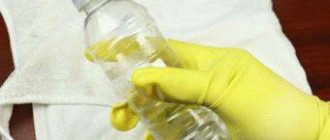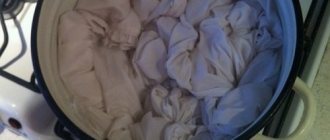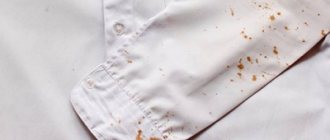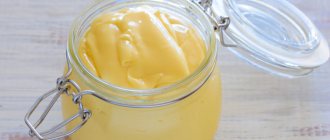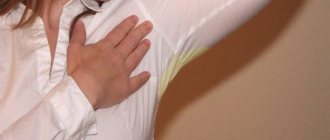A cup of invigorating aromatic coffee in the morning is an excellent ritual that snatches a person’s consciousness from the clutches of Morpheus. But the morning rush can lead to awkward movement and a brown stain on your clothes. There is no time to do laundry and search for recipes on how to wash coffee and how to remove coffee stains from white, and you can’t leave clothes with dirt - then it will be difficult to get rid of traces of the drink. You need to clean your clothes using the products you have at home.
Traces of coffee are brown in color of varying intensity with fairly clear contours. It is necessary to remove the color of the stain, but not to change the color of the fabric. Therefore, the approach to removing a dark coffee stain from clothing will vary depending on the type of fabric, its shade and the age of the stain.
The most effective and well-known methods for removing coffee stains
Coffee quickly and reliably eats into the fabric due to the fats and organic molecules it contains - tannin, which is used in production to increase the durability of dyes. Therefore, coffee imprints cannot be removed by regular washing. Chemical or household cleaning products are usually used to combat stains. Please note that after using any of these methods, the item must be washed by hand or in a washing machine.
Stain remover
Purchase a special stain remover whose task is to combat stains caused by tannin. Pay special attention to ensure that the product is suitable for the type of fabric being stained. Each package contains detailed instructions for using the substance. Apply the stain remover to the stained area and leave for the time specified in the instructions. After soaking, wipe the stain with a sponge soaked in liquid detergent and rinse with water.
Boiling
Only natural cotton fabrics can be boiled, so be sure to read the label on the item before using this method. Boil water in a large saucepan and add grated soap and powder to the mixture, then immerse the item in the container and simmer over low heat for 30 minutes.
Soap
Regular laundry soap copes well with coffee stains. Pre-rinse the stained area with hot water. When the mark disappears a little, rub it thoroughly with laundry soap until foam forms and leave for 10-15 minutes. Finish the procedure by rinsing the item in warm water. If this doesn't work, try another method: turn the soap into shavings using a grater and pour boiling water over it. Wait for the thick solution to cool and apply to the stain with a sponge or brush. After 30 minutes, repeat the procedure.
Salt
Dilute 2 tbsp in 1 liter of warm water. spoons of salt and soak the item in the solution for several hours. The same recommendations for preparing a solution and manipulating a contaminated item can be used with soda.
Hydrogen peroxide
Hydrogen peroxide is great for removing coffee from white cotton items. Dampen the stain with peroxide and wait 15-20 minutes. Keep in mind that it is not recommended to soak colored fabrics in peroxide, as the colors may become discolored.
Peroxide and ammonia
Peroxide with a few drops of ammonia added will have a greater effect. The stain can also be washed using pure ammonia, but only on a thick cloth: just moisten the stain with alcohol and leave for 10 minutes.
Petrol
Gasoline is a fat solvent, so it works well on café au lait stains. Please note that clothing should be cleaned using purified lighter fuel. Apply a small amount of product to the stained area and then blot with a napkin.
White vinegar
Make a paste of vinegar, baking soda and laundry detergent. First, mix 100 g of powder and 30 g of soda. Then add vinegar to make a mushy mass. When the acid is added to the alkali, a reaction occurs and the product begins to foam. Apply foam to the stained area for 5 minutes and rinse with water. Use only table vinegar.
Window cleaning liquid
Since such products most often contain ammonia, they can also be used as a way to remove coffee stains. Moisten the stained area with liquid and immediately wipe with a dry cloth from the edges to the center.
Glycerol
Heat liquid glycerin in the microwave (or in a water bath). When the liquid becomes warm, soak a cotton pad and pad in it and wipe the stain. Replace the darkened tampon with a new one. As soon as the coffee stops being absorbed into the cotton wool, pour glycerin into the stain for about an hour. The product can remove even old stains that were created several months ago.
The product is used not only in its pure form, but also in the form of a cleaning paste, mixed with salt. Apply the resulting slurry to the contaminated area and cover with polyethylene for 10 minutes. Remove the film and rub the mixture in with your hand, rinsing off the residue with water. Repeat the procedure, but wait not 10, but 20 minutes.
Lemon
Lemon juice works well for removing coffee stains from white clothes. Squeeze the juice of several lemons and apply to the stain. To prevent it from spreading, moisten the area around the stain with cold water. Leave for 30 minutes.
Citric acid has the same effect. Dissolve 1 sachet of acid in a glass of boiling water and pour over the stain, after wetting it with cold water. Place cling film on each side and wait 15 minutes.
Turps
Turpentine oil (purified turpentine) removes stains well in combination with salt and glycerin. In this case, salt is diluted in turpentine in a ratio of 1:2.5, and glycerin is 1:1. Rub the resulting product with a sponge or brush and leave for 30 minutes.
Dishwashing liquid
Lather 2 tbsp. spoons of detergent in half a glass of water. Apply the resulting foam to the stained area of the product and leave for 15 minutes.
Boiling water and hot water
Of course, ideally you need to soak the item immediately after a coffee stain has formed, but this is not always feasible. But you will most likely succeed in exposing only the stained area under a stream of hot or warm water: keep the stain under the stream until it is washed out. If the stain is not completely gone, sprinkle it with salt and use one of the methods listed below at home.
To easily wash off dried coffee, pour boiling water over it: slowly pour hot water from the kettle onto the stain, and then wash as usual.
Advice
Please note that boiling water can only be used on cotton or linen, as it can damage wool, silk and synthetics.
How to wash coffee from different fabrics
Knowing just how to deal with coffee stains is not enough. It is imperative to consider the type of fabric that needs to be cleaned. Some substances corrode the colored pigments on the fabric and discolor it. You might just ruin the thing. Before using any of the above methods, check the material specifications on the label.
White clothes
Getting rid of coffee on white is much more difficult than on colored fabrics. Contaminants are more difficult to remove, and they themselves are much more noticeable. If you spill coffee on your clothes, wash them with bleach to get rid of the stains and make them snow-white. Difficult-to-remove coffee stains are removed using hydrogen peroxide, citric acid, and oxalic acid. On very thick fabrics, coffee is removed using lime. Dissolve it in water and spread over the stained areas.
Clothes made from colored fabrics
When cleaning colored items, try not to remove the paint from the fabric; use gentle substances. Sodium salt of boric acid (borax) is well suited for removing stains. Make a solution of a teaspoon of powder and 50 ml of warm water and wipe the stained area.
You can use lemon juice and serum, applying a small amount to the stained area and leaving for 30 minutes.
Wool
You should hurry up when removing stains from woolen items. Due to the loose structure of the fabric, spilled coffee is quickly absorbed and difficult to clean up. To combat coffee stains, use ammonia. To begin, wet the problem area with warm water and rub with soap. Then rub a small amount of ammonia with a brush or sponge.
For convenience, place napkins under the fabric and replace them when they get wet. Remove stains from light-colored wool using hydrogen peroxide. Try to get rid of old stains by soaking a piece of clothing overnight in a solution of glycerin, ammonia and water in equal proportions.
Silk
Silk is a delicate fabric, so stains need to be treated with extreme care. First try applying the selected product to an inconspicuous area and see if the structure of the fabric has changed. It is advisable to wash the soiled item immediately; there is a chance that the coffee will disappear with a simple wash. If that doesn’t work, try moistening the stain with glycerin or borax and leaving it for a couple of hours.
Linen
You can remove coffee stains on linen clothes using bleach and oxalic acid. Pre-soak the item in soapy water for 10-15 minutes, and then dampen the stain with concentrated bleach. To remove oxalic acid stains, dilute a teaspoon in half a glass of water and apply to the problem area.
Cotton
You can remove coffee from cotton using baking soda. Add 6 tbsp to 10 liters of warm water. spoons of soda and soak the item of clothing, after moistening the stain with laundry soap, for about 30 minutes. If the mark does not disappear after washing, repeat the manipulations with soap.
Synthetics
To remove coffee stains on synthetic fabrics, use vinegar, baking soda, and hydrogen peroxide. The remedies are effective both individually and together. They need to be mixed in equal proportions.
Costume
To combat drink stains on your suit, use regular salt and refined gasoline. As soon as you place the stain, blot it with a napkin to absorb excess liquid. Cover the problem area with salt and wait. Then shake it off and wipe the cloth with purified gasoline.
Jeans
To remove stains from denim, ammonia, citric acid, and oxalic acid are suitable. Dilute 3 tbsp. spoons of ammonia in a glass of water, moisten the mark and rub with a soft brush. A solution of acids is prepared in a ratio of 2 tbsp. spoons per glass of water and, just like ammonia, applied to the stained area, rubbed with a brush. Pay special attention to denim clothing in rich colors. To avoid spoiling the item, first try the prepared solution on an inconspicuous area.
Leather Products
If you spill coffee on your favorite bag or jacket, then get ready to wipe it with gasoline or turpentine. The main thing is not to overdo it, otherwise you will dry out the product and it will begin to crack. After cleaning, soak the fabric with castor oil or shoe polish. If you have special care products, then use them! You need to moisturize your skin as much as possible after such work.
To remove coffee stains from suede, all you need is a simple soap solution and a soft sponge. After applying the solution, give it time to sit on the fabric and then carefully clean off the stain. If someone advises you to clean your suede with a greasy gel, send the person to hell! This will only make things worse.
Removing coffee stains from furniture
Sometimes not only clothes, but also furniture and other interior items suffer from a spilled drink.
From the carpet
First, blot up coffee spills on the carpet with a clean, dry cloth. To prepare the solution, mix 1 teaspoon of carpet detergent with 1 liter of water. Then wet the mark with clean water, then apply the cleaning mixture with a sponge and leave for 15-20 minutes. You need to wash off the composition with a slightly damp cloth.
From the sofa
Regular dishwashing detergent removes stains from upholstery of upholstered furniture well. As soon as you spill coffee, immediately blot the area with a dry towel. Soak a damp natural cloth in dishwashing detergent and rub the stained area until foam forms. Finally, remove excess chemicals and water with a slightly damp towel. A solution of vinegar and water or table salt works well to remove coffee stains on white fabric.
From the mattress
Use laundry soap to remove coffee stains from your mattress. Rub the sponge with soap and apply foam to the problem area, then wipe with a damp cloth or towel. If the stain is old, treat it with a solution of citric acid, a mixture of glycerin and salt, or ammonia. When finished, wipe the cleaned fabric with a damp cloth.
Vinegar
A mixture of equal parts vinegar, water and washing powder applied to a stain can help wash even very heavily soiled items. Apply the solution to the stain, wait 5-10 minutes and rinse the product thoroughly. It is also convenient to use a solution of vinegar and water (1:1) to treat a stained sofa or carpet of any color.
Advice
If the product (for example, a sofa or carpet) cannot be placed under running water, try to remove as much coffee from the pile or upholstery as possible with napkins. This will greatly facilitate further manipulation of the stain.
So don’t rush to throw away a damaged item: even dried coffee can be washed off from any product if you know truly proven products!
How to Remove Old Coffee Stains
To get rid of coffee stains that were left several weeks or months ago, you can use:
- A mixture of water with glycerin or borax. Soak the stained area with the solution for at least 30 minutes.
- Old stains are removed from white natural fabrics using hydrogen peroxide.
- Ammonia is good for removing marks on synthetics. Moisten the affected area with ammonia and leave for 20 minutes.
- Using warm glycerin you can remove old coffee stains from wool, plush or carpeting.
Soap
It is allowed to use both laundry and tar soap of high concentration (72%). You should not buy a product with additives like “Antipyatin” or “Eared Nannies”, they are less effective.
- Break off ¼ of the soap bar and grate it on a grater with a small section. Pour boiling water (300 ml) over the shavings and stir with a wooden spatula or spoon. When the mixture becomes homogeneous, let it cool. Soak a foam sponge in the solution, apply the mixture to the coffee stain, and leave to soak for half an hour. When the time is up, scrub the product with a toothbrush and repeat the steps. 2-3 procedures are enough to completely remove a fresh stain. In the case of old stains, increase the amount of chips to 1/3 per 300 ml. water.
- The technique is designed for cotton, preferably white. In rare cases, you can use the composition to remove stains from the surface of dark and colored clothing. Pour 300-350 ml into an enamel pan. clean water, add 30 g. baking soda, boil. Rub a small square of soap about 2*2 cm in size and add it to the water. When the composition dissolves, do not cool it. Place the item on a flat surface above the bathtub, pour the solution into a glass container with a convenient neck. Water the coffee stain with a thin stream, maintaining a height of 50-60 cm. When finished, wipe the coffee stain with a brush, and remove again if necessary.
How to remove a café au lait stain
To say goodbye to a café au lait stain, first apply a grease-dissolving agent to the stained area. This could be refined gasoline or dishwashing detergent. After the milk fat has been removed, clean the garment using any method appropriate for the type of fabric.
Take these tips into account and follow these simple rules for dealing with spilled coffee. Try to get rid of stains immediately, do not rub the liquid over the surface. Clean the stain from the edges to the middle. If a drink spills on an expensive item, it is better to use dry cleaning services.
First steps: what not to do
As soon as an unexpected situation occurs, the question arises whether the coffee will be washed off or whether the damaged item will have to be thrown away. We can reassure you: in most cases, coffee stains can be removed without a trace if you follow the cleaning rules. To avoid worsening the condition of your clothing, you should not take the following actions immediately after the incident:
- try to remove coffee stains with boiling water or hot water (temperature above +60 ℃);
- use wet wipes, trying to rub the contaminated area with them. This will only increase the area of the stain and rub the dye tightly into the fibers of the fabric;
- use bleaches on colored materials;
- try to remove the stain with caustic chemicals from delicate silk and other delicate fabrics.
When washing coffee, do not use aggressive cleaning agents for delicate fabrics, so as not to spoil the item.
Also, do not delay removing the stain for too long. The sooner you take action, the greater the chance that not a trace of contamination will remain.
In the washing machine: on what mode, at what temperature?
Once the preparatory issues have been resolved, you can begin the main wash.
Before washing, experienced housewives recommend running the washing machine idle for ten to fifteen minutes. This will help keep your clothes from pilling.
Algorithm of actions:
We put the selected clothes into the drum of the washing machine.
Attention: do not load the washing machine to capacity. There should be some space left in the drum so that dark items can be rinsed thoroughly.- We set the temperature mode. At what degrees to wash: for delicate fabrics (wool or silk) the water temperature should not exceed 30C, for other types of fabrics the water temperature should be set at 40C.
- Set the washing mode. For dark fabrics, the most suitable are gentle, fast modes (daily, delicate washing) that allow you to preserve the structure of the fabric as much as possible and remove all contaminants.
- We set the minimum number of revolutions, and if possible, the additional rinse function.
- Let's start the wash.
Choosing a detergent
To wash black clothes, you can only use special gels or liquid products marked “for dark clothes.”
Why regular powders are not suitable for dark clothes:
- Abrasive particles of dry powder wash out paint from fabric fibers (there is a high risk of whitish spots and loss of brightness).
- Powder granules dissolve very poorly in cold water. As a result, during the rinsing process, part of the powder remains in the fibers of the black fabric, creating unattractive stains and smudges.
Before purchasing a detergent for black clothes, you must carefully study the information about what type of fabric it is intended for.
There are several groups of liquids and gels: for washing delicate fabrics (silk), for wool and universal products.
This video will tell you how to wash black clothes so they don’t lose color:
What is possible and what is not?
White clothes cannot be washed with black clothes. Otherwise, light fabric takes on a gray tint, and black fabric, on the contrary, becomes lighter.
An exception may be dark-colored items with white accents . In this case, things are washed very carefully by hand using gentle gels or liquid detergents.
You can wash black items with colored ones only if you are completely sure that none of the selected items will fade.
wash black clothes together with blue and gray items only with properly selected detergents , at a water temperature no higher than 30C.
You can find out more about how to wash black items with white items here. About joint washing with gray things - here, with colored ones - in this article.
